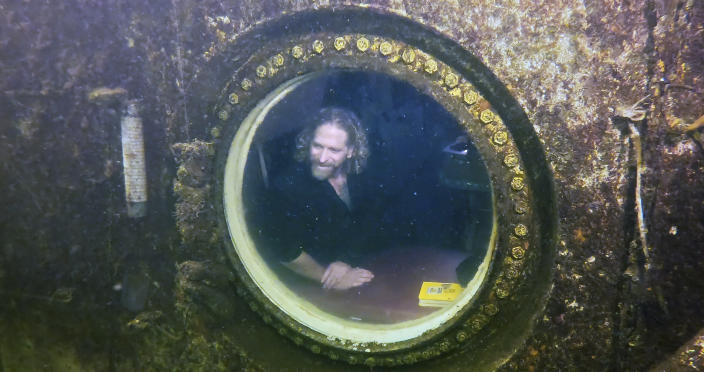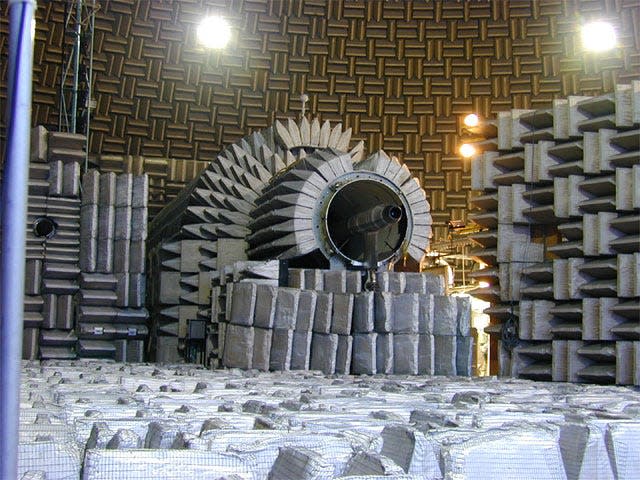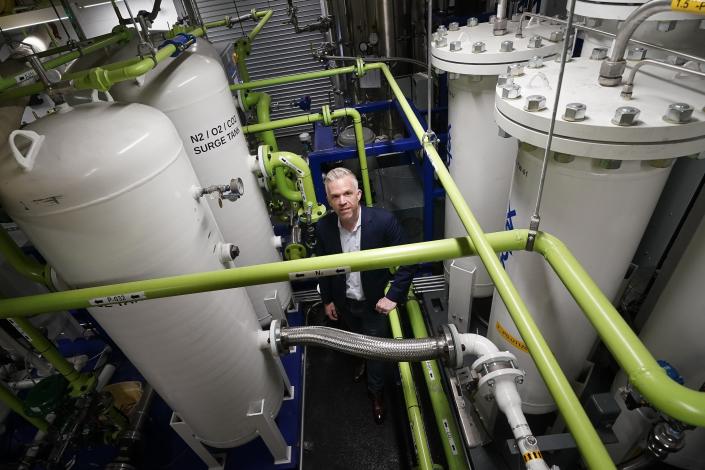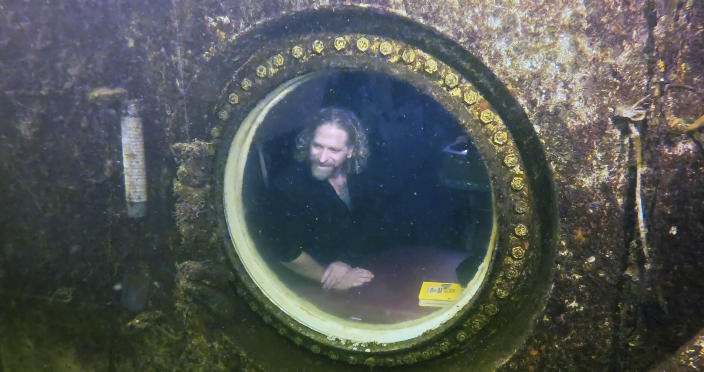Science Daily News | 16 May 2023

Views (199)

How scientists create the most explosive substance in the universe
Antimatter can help physicists solve questions like why is the universe mostly made up of matter and, ultimately, why we exist in the first place.

CERN is the only place on Earth that manufactures antimatter particles via high-energy collisions.
Just a tiny amount of antimatter is capable of generating an explosion equivalent to a nuclear bomb.
Luckily, there's not nearly enough money or time to produce enough antimatter for that kind of bomb.
CERN is the largest particle physics laboratory on Earth. Its antimatter factory looks unassuming from the outside and isn't a place where you might think to look for the most explosive material in the universe.
Antimatter is made up of elementary particles identical to regular matter, except with the opposite electrical charge. When the two come into contact, they annihilate, transforming into energy. Just one gram of antimatter could create an explosion equivalent to a nuclear bomb.
In theory, the Big Bang created matter and antimatter in equal amounts, which should have caused both types of matter to annihilate each other completely. But we live in a universe made almost entirely of regular matter.
At CERN's antimatter factory, physicists create antiprotons and antihydrogen to study their properties and help answer fundamental questions about the universe's origins and why we even exist in the first place.
To create antimatter particles, physicists start with this Proton Synchrotron Booster, shown here, which delivers an accelerated beam of about 10 trillion regular protons to the Proton Synchrotron.
The Proton Synchrotron further accelerates the beam along its 628-meter circular path, shown here, and smashes it into a block of mostly the chemical element iridium. The proton beam interacts with the iridium, producing about four antiprotons per every millionth collision. But these antimatter particles still have a long way to go from here.
The energetic, chaotic-moving antiprotons are then fed into the Antiproton Decelerator, which uses powerful magnets, shown here in blue, to slow the antiprotons down and direct them around the ring of the Antiproton Decelerator.
The antiprotons then enter quadrupole magnets, like the red one shown here, which compresses them together, against their natural urge to repel each other.
The Extra Low Energy Antiproton Ring, shown here, reduces the speed of antiprotons — to about 1.5% of the speed of light — which helps physicists trap the antimatter particles.
One of the final stages of antimatter production involves a vacuum, otherwise any antimatter would be annihilated when it contacts regular matter. This section of the vacuum chamber heats to around 250°C (482°F) to remove gas and water vapor, leaving a near-perfect vacuum in the middle of the chamber.
Source: Physicist and antimatter expert at CERN, Sameed Muhammed
A pressure gauge monitors the vacuum conditions to avoid a matter-antimatter encounter. But even if there were such an encounter, these experiments produce such tiny amounts it would take 10 trillion years to make just .25 grams of antimatter, the amount needed for a theoretical "antimatter bomb."
Source: Sameed Muhammed
Penning traps, like the one shown here, are cooled to nearly absolute zero temperatures and use an extreme vacuum and an electromagnetic field to trap antiprotons and antielectrons — the building blocks of antihydrogen.
Penning traps contain ultra-thin foils, about 1.5 micrometers thick, that further slow down and capture antiprotons sent from the ELENA ring. Before ELENA was installed in 2018 to help slow down antiprotons even more, CERN caught less than 1% of antiprotons it produced. Now, it captures up to 70%.
After ELENA slows them down, antiprotons make their way to different experiments in the antimatter factory. The AEgIS experiment, for example, uses the antihydrogen production trap, shown here, with strong magnets on each side that capture antimatter. Physicists then observe gravity's effect on it.
Another experiment, called ASACUSA, is testing the theory that antiprotons have the same mass as regular protons, according to the CPT (charge, parity, and time reversal symmetry) theorem.
In the ALPHA experimental zone, superconducting magnets filled with liquid helium help trap antiparticles. In 2011, the Alpha experiment at CERN successfully stored 309 antihydrogen atoms, with some atoms remaining trapped for nearly 17 minutes, "which is forever" one physicist described at the time.
Still, antimatter is extremely expensive and inefficient to produce. Making one gram of antimatter would cost an estimated $62.5 trillion dollars. That's why CERN makes such a limited amount — fewer than 10 nanograms in total since it began antimatter production in 1995.
Sameed Muhammed, a physicist working on antimatter production at CERN, helped with photo sourcing and information in this story.
Inside one of the strangest looking NASA test sites where sound goes to die
NASA's Auero-Acoustic Propulsion Lab is an anechoic chamber — a room without echoes. Its spiky, fiberglass wedges absorb sound.

NASA's Aero-Acoustic Propulsion Lab is basically a graveyard for sound.
Every surface inside is covered with 17,000 spiky wedges that absorb sound and prevent echoes.
Nicknamed "The Dome", AAPL provides highly accurate sound level readings for aircraft and rockets.
For over 20 years, AAPL has functioned as an anechoic chamber — a room without echoes. It's essentially a graveyard for sound.
If you stood at the entrance and shouted "Hello" to a friend in the center, they would barely hear your voice, even though you'd only be 65 feet away, said Luke Thompson, a mechanical test engineer at AAPL.
Inside The Dome, Thompson and his team test models of new rocket and jet engine parts to see how much noise they make. NASA, commercial airplane manufacturers, and even the military use that information to develop quieter aircraft.
The source of AAPL's silence is two-foot-long fiberglass wedges — 17,000 of them.
These wedges cover every surface, lining the walls, the floor, and even the test equipment itself. They look like chalky gray Toblerones, or a giant's Lego set.
Obviously, spiky fiberglass wedges would be hard to walk across for anyone who isn't a gymnast.
Thankfully the ones on the floor can be moved out of the way whenever Thompson and his team need to roll in the latest engine part they're testing.
Thompson said AAPL can test larger engine models than most other aero-acoustic labs.
While The Dome isn't large enough to contain a whole rocket, it doesn't really need to, since the engine (or a specific engine part) is the only equipment being tested.
The Nozzle Acoustic Test Rig, a spiky-looking wind tunnel 53 inches in diameter, is the machine Thompson's team uses the most. "That's our bread and butter," he said.
The NATR tests prototypes of engine nozzles, which are the tubes that exhaust shoots out of to give an aircraft thrust.
The nozzles can reach up to 1,425 degrees Fahrenheit during testing, so you can't exactly stand next to NATR and hold up a microphone to capture the noise.
Thompson said NASA doesn't even let scientists stand outside The Dome during testing, for safety's sake.
Instead, they monitor the test in a separate facility, analyzing data from the 24 microphones set up near the dome's roof (and additional microphones as needed).
So while the engine nozzle is roaring with flames, sound waves fly out in every direction. The sound waves hitting the microphones directly get recorded.
Meanwhile, the ones hitting the wedges are suppressed and absorbed, so they can't echo back toward the microphones and add a second layer of noise data. The wedges, while funny-looking, are essential to get the most accurate acoustic readings possible.
But why go through all this trouble to measure acoustics so precisely? There could be a few reasons, depending on the aircraft.
For example, the military has used AAPL to help design quieter jets for surveillance missions. After all, spying can be rather difficult if combatants can hear your plane screeching across the sky.
Meanwhile, commercial airplanes need to be quiet both for employees' and passengers' comfort.
Thompson said noise reduction is also important for people who live near airports since they have to listen to flights all day.
The Dome fills an important role in making sure new aircraft parts meet these guidelines. Despite its loud and pointy design, The Dome helps make the world a quieter place.
People used to fight over getting a COVID-19 vaccine. Now millions of doses are getting tossed in the trash because no one's using them.
According to CDC data, nearly a third of the total J&J doses produced went unused. The last batch has now been trashed.

The Johnson & Johnson single-dose COVID-19 vaccine is no longer available in the US.
Over two years after it was first approved, the last batch of doses has been thrown out.
Americans once fought over vaccines, but still, nearly a third of doses produced went unused.
At the height of the COVID-19 pandemic, Americans were clamoring to get vaccinated as soon as they could.
But now, millions of doses of the Johnson & Johnson vaccine are getting tossed in the trash because no one's using them.
The 12.5 million remaining doses — nearly a third of the total produced — expired on May 7, and the CDC has told all vaccine providers to get rid of them.
And even for those who followed the rules, wait times for vaccine appointments at the height of the public health crisis were often days — or even weeks.
Sheep methane emissions testing 'a UK first'
The work by Scotland's Rural College could help find solutions to reducing the animals' carbon footprint.

Scottish scientists have been using mobile testing equipment to measure greenhouse gas emissions from sheep.
Scotland's Rural College (SRUC) said it was the first time the New Zealand-designed portable accumulation chambers (Pacs) had been used in the UK.
The equipment helps scientists visit farms and analyse methane concentrations from sheep to identify which of their genetics and feed produce the highest emission levels.
SRUC's Dr Nicola Lambe said there was an urgent need to mitigate greenhouse gas emissions from sheep.
The scientist said there were an estimated 1.2 billion sheep in the world producing about seven million tonnes of methane into the atmosphere.
Edinburgh-based SRUC's research could help find solutions to reducing the animals' carbon footprint.
Dr Lambe said: “Despite the fact resource efficiency and greenhouse gas emissions are global priorities, there are few examples around the world of research to implement breeding strategies to directly tackle these issues in sheep.
“This is largely due to the difficulty in recording feed consumption and greenhouse gas emissions on an individual animal basis, especially in grass-based systems."
Rob Hodgkins, who farms 2,500 in Hertfordshire, was involved in the first use of the trailer-mounted Pacs.
He said: "It will only be a matter of time before consumers will be able to look at labels on packets of meat that shows what they’re buying has come from, for example, a carbon-zero sheep.”
The announcement formed part of wider UK proposals on how to meet climate targets.
Methane is the most common greenhouse gas after carbon dioxide (CO2).
Livestock such as cows, sheep and deer produce methane when their stomachs are breaking down hard fibres like grass for digestion.
This fermentation process creates methane gas which is then mostly belched out again.
NYC skyscrapers turning to carbon capture to lessen climate change
From the outside, the residential high-rise on Manhattan's Upper West Side looks pretty much like any other luxury building: A doorman greets visitors in a spacious lobby adorned with tapestry and marble. In an effort to drastically reduce the 30-story building's emissions, the owners have installed a maze of twisting pipes and tanks that collect carbon dioxide from the massive, gas-fired boilers in the basement before it goes to the chimney and is released into the air. Buildings are by far the largest source of greenhouse gas emissions here, roughly two-thirds, according to the city buildings department.

NEW YORK (AP) — From the outside, the residential high-rise on Manhattan's Upper West Side looks pretty much like any other luxury building: A doorman greets visitors in a spacious lobby adorned with tapestry and marble.
Yet just below in the basement is an unusual set of equipment that no other building in New York City — indeed few in the world — can claim. In an effort to drastically reduce the 30-story building's emissions, the owners have installed a maze of twisting pipes and tanks that collect carbon dioxide from the massive, gas-fired boilers in the basement before it goes to the chimney and is released into the air.
The goal is to stop that climate-warming gas from entering the atmosphere. And there's a dire need for reducing emissions from skyscrapers like these in such a vertical city. Buildings are by far the largest source of greenhouse gas emissions here, roughly two-thirds, according to the city buildings department.
New York state’s buildings also emit more air pollution than any other state's.
As a result, property managers are scrambling to change how their buildings operate. Some are installing carbon capture systems, which strip out carbon dioxide, direct it into tanks and prepare it for sale to other companies to make carbonated beverages, soap or concrete.
They see it as a way to meet emissions goals without having to relocate residents for extensive renovations. In this case, the carbon dioxide is sold to a concrete manufacturer in Brooklyn, where it's turned into a mineral and permanently embedded in concrete.
“We think the problem is reducing emissions as quickly as possible," said Brian Asparro, chief operating officer of CarbonQuest, which built the system. “Time is not on our side, and this type of solution can be installed quickly, cost-effectively and without a major disruption.”
Yet critics, many of them representing environmental groups, say building managers should be going much further: They argue that to achieve meaningful reductions in emissions, buildings should be significantly upgraded and switched to renewable-powered electricity instead of continuing to burn fossil fuels. They also express concerns about the safety of storing large amounts of carbon dioxide, an asphyxiant, in a densely populated community.
“Carbon capture doesn’t actually reduce emissions; it seeks to put them somewhere else,” said Anthony Rogers-Wright, director of environmental justice at New York Lawyers for the Public Interest. “The emissions still exist. And we should be clear that the only way to reduce emissions ... is to stop emitting.”
It’s still unclear whether carbon capture technology will even be recognized by New York City as a qualifying emissions reduction; the city has yet to decide. Asparro and others are trying to persuade city officials to accept it.
CAPTURING THE CULPRIT
In the basement of the Upper West Side apartment building, two hulking 500-horsepower boilers rumble, burning natural gas and releasing carbon dioxide. The boilers, which are expected to last another 10 or 20 years, produce roughly half the building's emissions, Asparro said.
The other half of the emissions that, in the city's view, the building is responsible for, are those generated at the power plants where the building gets its electricity. The carbon capture system, Asparro said, is trapping about 60% of the boilers' emissions. All told then, including the electricity to power the system, it's reducing the building's emissions by roughly 23%.
“Boilers like this are installed everywhere, in schools and hospitals around the world,” Asparro said. “It's a really big challenge that buildings are facing in order to reduce emissions.”
The carbon dioxide and other gases are diverted from the chimney and piped into a room where a few parking spaces have been repurposed to house the carbon capture system. The gases flow over a special material that separates out the carbon dioxide. Then it’s compressed and cooled to minus-10 degrees Fahrenheit (minus-23 Celsius), turning it into liquid that's then stored in tanks. That process takes energy, and capturing carbon dioxide does increase the building's electricity use, but overall the system is still reducing the building's emissions.
More pipes lead to spigots outside the building, where a truck pulls up once or twice a week to load up with liquefied CO2. The truck carries it through city streets and across a bridge to Brooklyn, where it's sold to a concrete manufacturer.
Carbon capture technology has existed on an industrial scale for decades, used by oil and gas companies and some manufacturing plants to capture climate-warming carbon dioxide and either sell it, or use it to wrestle more oil from underground.
But now a handful of green tech companies and building owners are trying for the first time to deploy this technology on a much smaller scale on residential buildings. New York City's law requires buildings exceeding 25,000 square feet to reduce emissions. In Minnesota, Radisson Blu Mall of America, a hotel, has installed a system that captures carbon dioxide that's eventually used to make soap.
Building owners that can afford to pay for carbon capture equipment do receive some federal tax breaks for installing the systems. There are other incentives available to help update buildings, according to NYC Accelerator, a program that helps homeowners and property managers find ways to reduce emissions.
To reduce energy use, the apartment building also has computerized motors, fans and pumps, LED lighting and battery storage, said Josh London, senior vice president at Glenwood Management Corp., which manages the building. The company plans to install carbon capture systems in five other buildings this year.
Without action, similar high-rise buildings could face fines of nearly $1 million annually starting in 2030, Asparro estimated.
Nearly 70% of New York City’s large buildings have steam boilers that run on natural gas or oil, according to NYC Accelerator. Many have heating systems more than a half-century old, and often they’re under-maintained, said Luke Surowiec, director of building decarbonization at ICF, a consulting firm which manages NYC Accelerator.
“Our buildings are very old and inefficient, and that’s the reality,” Surowiec said. “There are a ton of opportunities that haven’t been realized.”
MINERALIZING INTO CONCRETE
Over in Brooklyn, the floor rattles and shakes as yellow machines churn at Glenwood Mason Supply Company Inc., a concrete maker unrelated to Glenwood Management Corp. Grey blocks rattle down a conveyor line under a din of metal gears and motors. Somehow, birds have moved in and fly between towering piles of blocks.
As concrete ingredients churn in a structure resembling a pizza oven, the carbon dioxide, now essentially dry ice, flows in like a mist. The carbon dioxide reacts with calcium ions in cement, one of the ingredients of concrete. This forms calcium carbonate, which becomes embedded in the concrete.
Once carbon dioxide is in that mineral state, it's secure and it won't be released unless it's heated to about 900 degrees Celsius (1652 degrees Fahrenheit), said Claire Nelson, a geochemist who specializes in carbon capture at Columbia Climate School.
“So unless a volcano erupts on top of your concrete building, that carbon is going to be there forever,” Nelson said.
Adding mineralized carbon dioxide to concrete can reduce its carbon footprint, though not by much. On average, concrete producers using CarbonCure technology reduce their carbon footprint by just 5% to 6%, said Robert Niven, CEO of CarbonCure, which works with 700 concrete producers in 30 countries.
Connie Cincotta, owner of Glenwood Mason, said her company takes other measures as well, for example to reduce the amount of cement in its concrete mix, by adding post-industrial glass that would have gone to landfills.
“If there's any way we can get cement out of the mix, that’s helpful,” she said.
The company's concrete blocks with mineralized CO2 have been used in buildings owned by Amazon and a Manhattan charter school, among others.
QUESTIONS REMAIN
Many environmental groups remain skeptical of carbon capture and instead favor investing in a transition to renewable energy. They also fear that it could be unsafe to store carbon dioxide, which in extreme concentrations can lead to suffocation, in a residential dwelling.
Storing concentrated carbon dioxide under a residential building is worrisome, because “in the case of Mississippi, people weren’t actually living right on top of it,” Rogers-Wright said. “We’re talking about big buildings here in New York City. So the risks are unknown, but they certainly are apparent.”
There's also a risk of leaks, he said, if a truck transporting carbon dioxide were to get into an accident.
Proponents of carbon capture technology respond that there are safeguards to prevent such scenarios. The carbon capture technology installed in the Manhattan apartment, Asparro said, was permitted by multiple city agencies.
“We have carbon dioxide everywhere in cities," he added. "Hospitals, restaurants, breweries — all utilizing carbon dioxide. And it’s being done in a fairly safe and manageable way.”
Nelson, the Columbia geochemist, who also started a carbon capture company, contends that having natural gas stored in basements is more dangerous than storing carbon dioxide, and many people accept those risks posed by natural gas.
The biggest challenge, proponents say, is scaling this and other solutions fast enough to make a difference in climate change.
That's why proponents say many solutions should be deployed at once.
Back in Manhattan, powering the apartment building entirely with renewable electricity isn’t possible yet because the local utility doesn’t have enough renewable energy to sell to all New York customers, London said.
And “with solar, you need a bigger footprint than what we have in a building like this,” he added.
London said he wants to buy power from wind farms once it becomes more widely available.
But “that’s going to take a long while, so I don’t think we have the luxury of sitting,” he said. “We can reduce our emissions while we wait for that.”
—-
Associated Press climate and environmental coverage receives support from several private foundations. See more about AP’s climate initiative here. The AP is solely responsible for all content.
A Florida man living underwater won't resurface even after breaking the record
A university professor broke a record for the longest time living underwater without depressurization this weekend at a Florida Keys lodge for scuba divers. Joseph Dituri’s 74th day residing in Jules’ Undersea Lodge, situated at the bottom of a 30-foot-deep lagoon in Key Largo, wasn’t much different than his previous days there since he submerged March 1. Dituri, who also goes by the moniker “Dr. Deep Sea,” ate a protein-heavy meal of eggs and salmon prepared using a microwave, exercised with resistance bands, did his daily pushups and took an hour-long nap.

KEY LARGO, Fla. (AP) — A university professor broke a record for the longest time living underwater without depressurization this weekend at a Florida Keys lodge for scuba divers.
Joseph Dituri’s 74th day residing in Jules’ Undersea Lodge, situated at the bottom of a 30-foot-deep lagoon in Key Largo, wasn’t much different than his previous days there since he submerged March 1.
The previous record of 73 days, two hours and 34 minutes was set by two Tennessee professors -- Bruce Cantrell and Jessica Fain -- at the same location in 2014.
But Dituri isn't just settling for the record and resurfacing: He plans to stay at the lodge until June 9, when he reaches 100 days and completes an underwater mission dubbed Project Neptune 100.
The mission combines medical and ocean research along with educational outreach and was organized by the Marine Resources Development Foundation, owner of the habitat.
“The record is a small bump and I really appreciate it,” said Dituri, a University of South Florida educator who holds a doctorate in biomedical engineering and is a retired U.S. Naval officer. “I’m honored to have it, but we still have more science to do.”
His research includes daily experiments in physiology to monitor how the human body responds to long-term exposure to extreme pressure.
“The idea here is to populate the world’s oceans, to take care of them by living in them and really treating them well,” Dituri said.
The outreach portion of Dituri’s mission includes conducting online classes and broadcast interviews from his digital studio beneath the sea. During the past 74 days, he has reached over 2,500 students through online classes in marine science and more with his regular biomedical engineering courses at the University of South Florida.
While he says he loves living under the ocean, there is one thing he really misses.
“The thing that I miss the most about being on the surface is literally the sun,” Dituri said. “The sun has been a major factor in my life – I usually go to the gym at five and then I come back out and watch the sunrise.”
0 Likes
